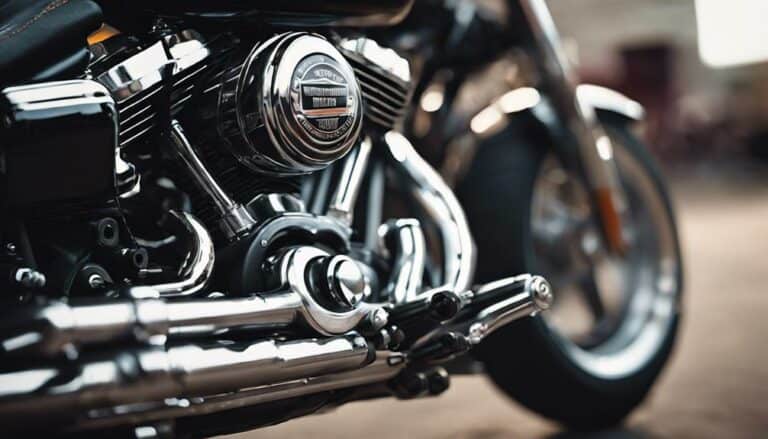Ever wondered what Harley Davidson pushrods are crafted from?
The material used in their construction plays a vital role in their performance, but have you ever considered what it is exactly that gives these components their strength and reliability?
Let's explore the composition of Harley Davidson pushrods and how it contributes to the legendary performance associated with this iconic brand.
Key Takeaways
- Harley pushrods are crafted from chrome moly steel or anodized aluminum for strength and durability.
- Chrome moly pushrods excel in high-performance engines, while aluminum pushrods are suitable for near-stock setups.
- Material choice significantly impacts engine performance and longevity in Harley pushrods.
- Precision manufacturing with chrome moly steel ensures robustness and quality in Harley pushrods.
Materials Used in Harley Pushrods
Harley Davidson pushrods are primarily crafted from either chrome moly steel or anodized aluminum, each offering distinct advantages based on performance requirements. Chrome moly pushrods stand out for their exceptional strength and durability, making them the ideal choice for high-performance engines with aggressive camshaft profiles. These pushrods excel in handling the stress and load demands of a high-performance valvetrain, ensuring reliable operation under extreme conditions.
On the other hand, anodized aluminum pushrods are preferred for near-stock engine setups due to their lightweight nature. While aluminum pushrods may not match the sheer strength of chrome moly variants, they offer ample durability for standard engine configurations. However, under heavy stress, aluminum pushrods may be prone to bending, making them less suitable for applications requiring high performance.
Ultimately, the choice between chrome moly and aluminum pushrods depends on the specific camshaft requirements and engine setup, where selecting the appropriate material is vital for optimizing engine performance and longevity.
Common Alloy for Harley Pushrods
Crafted from a specialized alloy, Harley pushrods offer a blend of strength and performance tailored to engine requirements. Here are some essential points to take into account when exploring the common alloy used for Harley pushrods:
- Chrome Moly Steel: The majority of Harley pushrods are constructed from chrome moly steel, a material renowned for its robustness and longevity in high-stress environments.
- Tapered Design: These pushrods are often tapered to guarantee ideal clearance at the cylinder head, enhancing overall performance and reducing the risk of interference issues.
- Threaded Adjustment: Featuring threaded adjustments, Harley pushrods facilitate straightforward cam installation and provide a convenient means of fine-tuning the valve train setup.
- Aluminum Alternatives: While less common, aluminum pushrods are available and are typically recommended for applications where weight reduction is a primary concern due to their lighter composition.
When deciding between chrome moly steel and aluminum pushrods, it's important to assess the specific demands of your engine setup to ensure top performance and durability.
Strength and Durability of Pushrods
When considering pushrods for your engine setup, the material choice between chrome moly steel and aluminum greatly impacts the strength and durability of your valvetrain system. Chrome Moly pushrods, favored for high-performance applications, offer superior rigidity and longevity, making them ideal for demanding camshaft setups and higher engine speeds. On the other hand, aluminum pushrods, while lighter, may not provide the same level of strength and durability as chrome moly steel. The table below summarizes the key differences between chrome moly and aluminum pushrods:
| Property | Chrome Moly Steel Pushrods | Aluminum Pushrods |
|---|---|---|
| Strength | High | Moderate |
| Durability | Excellent | Good |
| Weight | Heavier | Lighter |
| Performance | Superior | Moderate |
Choosing the right pushrod material is essential to ensure the throttle capacity, valve operation, and overall performance of your engine, especially in setups with four valves per cylinder, new overhead valve systems, rockers, and patented technologies. Make an informed decision based on your engine's requirements for the best results.
Harley Pushrod Manufacturing Process
Manufactured with precision engineering techniques, Harley-Davidson pushrods are meticulously crafted from chrome moly steel to secure high-quality rigidity and durability in high-performance applications. Here's a breakdown of the Harley pushrod manufacturing process:
- Tapered Design: The pushrods are tapered to guarantee excellent clearance at the cylinder head, enhancing overall performance in the engine.
- Marked for Precision: Each pushrod is clearly marked for either intake or exhaust, ensuring proper installation and function within the engine system.
- Material Strength: Chrome moly steel is chosen for its exceptional strength, making it the ideal choice for demanding conditions in high-performance engines like the Milwaukee-Eight®.
- Precision Engineering: Harley-Davidson employs advanced engineering techniques to guarantee that every pushrod meets strict quality standards, contributing to the overall reliability and longevity of the engine system.
This meticulous manufacturing process results in pushrods that can withstand the demands of bridge-type valve trains, rocker arm shafts, and adjustable pushrods in a pushrod engine setup.
Comparing Harley Pushrods to Others
Harley Davidson pushrods, crafted from chrome moly steel or anodized aluminum, stand out in comparison to pushrods used in other engine setups for their durability and performance characteristics. These pushrods play an important role in transferring motion from the camshaft to the valves.
In traditional Harley engines, a single pushrod operates a pair of rocker arms mounted on a fixed shaft. This design simplifies the valvetrain but can lead to issues such as valve bridges rotating out of line. To address this, Harley Davidson recently patented a new liquid-cooled DOHC platform in the United States. This innovative system features individual pushrods for each valve, allowing for more precise control and eliminating concerns about rotating components.
Conclusion
So, next time you hear the roar of a Harley Davidson engine, remember that sound is made possible by the chrome moly steel pushrods working tirelessly to deliver power and performance.
Just like a skilled conductor leading a symphony, these pushrods orchestrate the harmonious movement of the engine components, ensuring a smooth and powerful ride every time.
Choose Harley pushrods for a reliable and durable engine performance that will never let you down.

